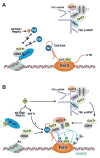Viral-host interactions that control HIV-1 transcriptional elongation
- PMID: 23795863
- PMCID: PMC4310557
- DOI: 10.1021/cr400120z
Viral-host interactions that control HIV-1 transcriptional elongation
Abstract
Regulation of the pause and elongation by RNA polymerase (Pol) II is used widely by metazoans to attain the pattern of gene expression that is essential for optimal cell growth/renewal, differentiation and stress response. Currently, much of what we know about Pol II elongation control comes from pioneering studies of the HIV-1-encoded Tat protein and its host cellular co-factors. The interaction between the two fuels a powerful feedback circuit that activates HIV transcription and prevents the virus from entering latency. One of the key Tat cofactors is the human positive transcription elongation factor b (P-TEFb), which exists in a family of complexes with distinct functions during Tat transactivation. This article reviews recent progresses in HIV transcription research with an emphasis on the intricate control of the various P-TEFb complexes, structural and functional insights into their interactions with Tat, the multifaceted roles of post-translational modifications of Tat and epigenetic control of HIV chromatin in modulating Tat activity and HIV latency. The knowledge from these studies will not only help design better strategies to fight HIV infection and transcriptional latency, but also advance the overall understanding of the mechanism controlling transcriptional elongation in general.
Figures






References
Publication types
MeSH terms
Substances
Grants and funding
LinkOut - more resources
Full Text Sources
Other Literature Sources

